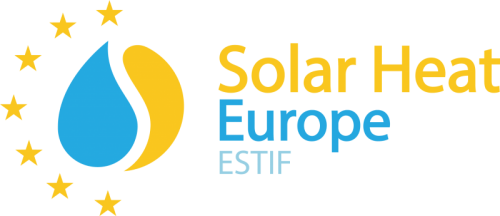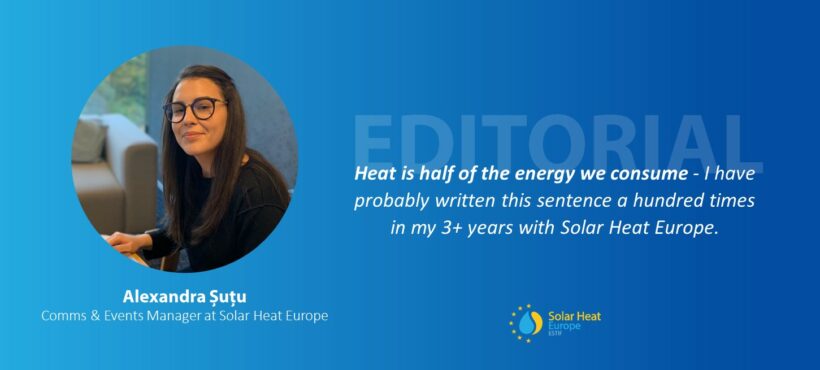Heat is half of the energy we consume – I have probably written this sentence a hundred times in my 3+ years with Solar Heat Europe. And I am not the only one; there are many others who have repeated this fact over and over.
You might wonder, why do we insist on this so much? The answer isn’t simple. Let’s take a step back and look at the bigger picture.
We are living in a complex world that is now also facing the challenges of climate change. The climate crisis, a human-made disaster, might be one of the biggest challenges humanity has ever faced. This fact is not just evident through reports produced by the scientific community but also in the increased frequency of extreme weather events happening each year. As a young person, I could lay down my frustration towards global leaders for their inaction on a topic they have been aware of for a long time. This frustration is shared by many other young people, as seen in movements like Fridays for Future. However, in this editorial, I choose a different path, because, despite the obvious challenges, there is a silver lining: the opportunity to reshape our society, embrace sustainability, and reduce greenhouse gas emissions.
Now, let’s zoom in on one of the crucial aspects that needs to change: our energy system. Energy, in all its forms, enables life as we know it today, from the charger plugged into your phone to the heating in your house or a big factory producing your favorite beer. Sometimes, we use energy without even realising it, often in industrial areas outside our cities, producing the goods we use daily.
In this context, the logical train of thought goes like this: to reduce emissions, especially those from the energy sector, we need to change how we produce and consume energy. And guess what? We have the solutions. Renewable energy technologies have advanced significantly. Europe has seen remarkable progress in the power sector for example, with an important share of today’s electricity coming from renewable sources.
But here’s the kicker: the majority of our energy needs are not in the form of electricity; but HEAT. Think about your hot shower, the cozy radiator in your home, or the heat needed in industries to prepare our food, drinks, paper, medicines etc. Heat is used everywhere, and the way we produce it today has a massive impact on our world.
So why do we keep saying “heat is half”? Because without decarbonising the heating sector, there is no real energy transition, no net-zero society— not by 2050 nor anytime in the future.
In the past, heat has not received the attention it deserves from policymakers. It has been overlooked. While we’re pushing for more renewable electricity and electric vehicles, we need to speed up the deployment of renewable heating technologies. The best part? We don’t have to wait; there are technologies available right now, like geothermal, modern biomass, heat pumps if powered with renewable electricity, and of course, solar thermal.
I mean, is it not just obvious to use the sun’s free energy for heating? And I am specifically talking about efficient and performant solar thermal technology, backed by over 30 years of innovation, that can provide hot water at home or even steam for industrial processes in sectors like textiles.
For the first time in over three years, I can see a slight change. I see it through our work and through the shift in the narrative around the energy transition from European level. Heat is finally getting more attention, partially thanks to the energy crisis Europe faced recently.
Renewable solutions are growing now. The solar thermal market grew by 12% in 2022 compared to the previous year, marking significant progress across all market segments, from buildings/residential systems to larger ones providing renewable heat to cities’ district heating or industrial sites.
Solar thermal can bring amazing benefits to our society, providing direct clean heat and ensuring energy security. It is a decentralised solution, installed locally, and produced in Europe, supporting local economies and creating green jobs. Also important, it is an off-grid solution that can cover a significant part of heat demand, alleviating the pressure on the power grid.
In the context of the upcoming European elections, we call on European and national policymakers and decision-makers from the private/financing sector, to stand firm. They must ensure the rapid and effective implementation of the climate and energy plans with concrete targets set in motion over the past 5 years. We call on them to actively promote and support solar thermal technologies, unlocking their potential to guarantee clean energy supply, enhance energy security, foster energy independence, and offer price stability to European citizens, from north to south.
Now, while I’m an advocate for solar thermal solutions, I know the energy transition is not about a single technology. In Brussels slang, “there’s no silver bullet for decarbonisation.” But in my opinion, instead of waiting for technologies that do not exist yet, we should maximise the capacity of the ones available now – all of them. More importantly, we should focus on deploying them as fast as possible, as much as possible.
So, as we keep repeating, “heat is half,” let’s remember, there’s renewable heat at the “end of the tunnel”. It’s up to us to harness it.
Alexandra Șuțu,
Comms & Events Manager at Solar Heat Europe


Leave a Reply